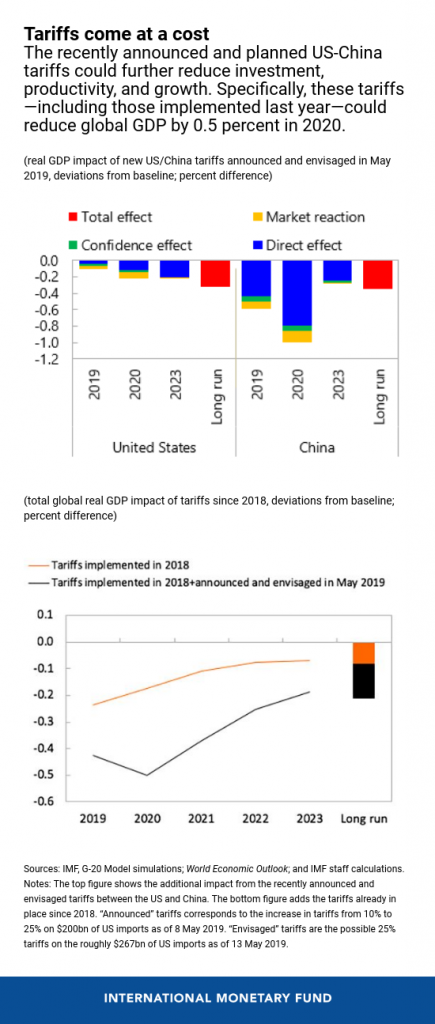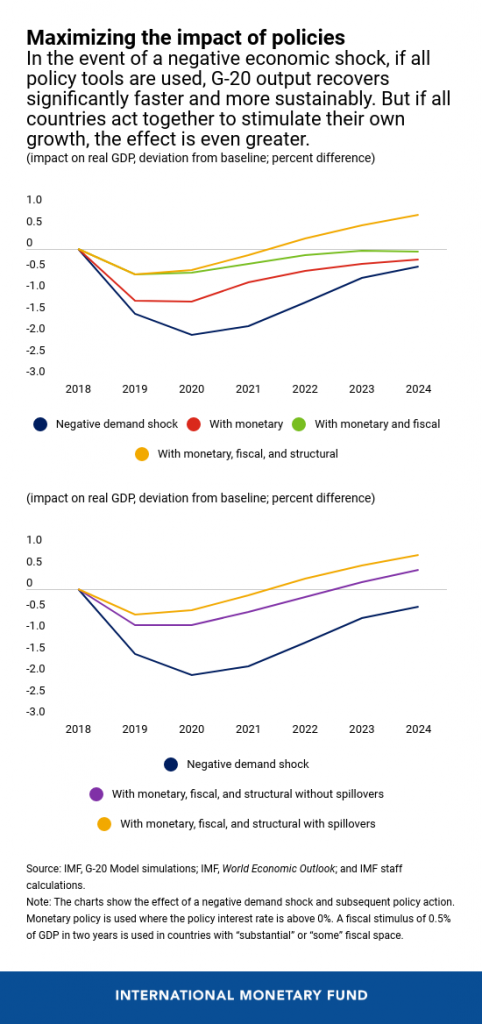Christine Lagarde:How to Help, Not Hinder Global Growth
2019-06-11 IMI These are self-inflicted wounds that must be avoided. How? By removing the recently implemented trade barriers and by avoiding further barriers in whatever form.
The fact is that protectionist measures are not only hurting growth and jobs, but they are also making tradable consumer goods less affordable—and disproportionately harming low-income households.
The G-20 can help
So how can G-20 policymakers help to clear these stumbling blocks and support a rebound in growth?
The immediate priority is to resolve the current trade tensions, while stepping up the modernization of the international trade system. This includes building consensus across countries on how to strengthen WTO rules, especially on subsidies, intellectual property, and trade in services. The goal is to create a more open, more stable, and more transparent trade system—one that is well-equipped to serve the needs of 21st-century economies.
For example, IMF research shows that liberalizing trade in services could add about US$350 billion to global GDP in the long run. These types of gains are critical if trade is to play its role in lifting living standards and creating new jobs with higher wages.
As countries are fixing the trade system, they also need to work together to reform international corporate taxation, strengthen the global financial safety net, and tackle the existential threat of climate change.
Strengthening resilience and inclusiveness
At the same time, we have to recognize that high public debt and low interest rates have left many countries with limited policy room for maneuver. Managing this challenge will require carefully calibrated fiscal policies that strike the right balance between growth, debt sustainability, and social objectives.
We also need to address dislocations caused by trade and technological innovation, while doing more to support those left behind.
And we need further structural reforms: from lowering barriers to entry in retail and professional services, to encouraging greater participation of women in the workforce. Of course, each country will customize reforms to meet its needs—but we estimate that these types of measures, if jointly implemented, could boost G-20 GDP by 4 percent in the long term.
Importantly, structural reforms would also make growth more resilient and inclusive.
Coordinate if growth falters
Even as we strive to support a pickup in growth in this way, countries need to ask, “what if?”
When the next downturn comes, which inevitably it will, policymakers may need to use all policy tools to maximize their combined effect. This means supporting demand through decisive monetary easing and fiscal stimulus wherever possible. It also means using these supportive policies to boost the impact of structural reforms where demand is weak.
Our G-20 note simulates a negative economic shock and the subsequent policy responses (see chart, top panel). Under one scenario, if all policy tools are used, G-20 output recovers significantly faster and more sustainably.
Moreover, policy coordination should not stop at the border. Our downturn simulation shows that, if all countries act decisively to stimulate their own growth, the positive spillovers reinforce each other. And if everyone is working to expand growth, everyone benefits from the efforts of others to a much greater effect overall (see chart, bottom panel).
These are self-inflicted wounds that must be avoided. How? By removing the recently implemented trade barriers and by avoiding further barriers in whatever form.
The fact is that protectionist measures are not only hurting growth and jobs, but they are also making tradable consumer goods less affordable—and disproportionately harming low-income households.
The G-20 can help
So how can G-20 policymakers help to clear these stumbling blocks and support a rebound in growth?
The immediate priority is to resolve the current trade tensions, while stepping up the modernization of the international trade system. This includes building consensus across countries on how to strengthen WTO rules, especially on subsidies, intellectual property, and trade in services. The goal is to create a more open, more stable, and more transparent trade system—one that is well-equipped to serve the needs of 21st-century economies.
For example, IMF research shows that liberalizing trade in services could add about US$350 billion to global GDP in the long run. These types of gains are critical if trade is to play its role in lifting living standards and creating new jobs with higher wages.
As countries are fixing the trade system, they also need to work together to reform international corporate taxation, strengthen the global financial safety net, and tackle the existential threat of climate change.
Strengthening resilience and inclusiveness
At the same time, we have to recognize that high public debt and low interest rates have left many countries with limited policy room for maneuver. Managing this challenge will require carefully calibrated fiscal policies that strike the right balance between growth, debt sustainability, and social objectives.
We also need to address dislocations caused by trade and technological innovation, while doing more to support those left behind.
And we need further structural reforms: from lowering barriers to entry in retail and professional services, to encouraging greater participation of women in the workforce. Of course, each country will customize reforms to meet its needs—but we estimate that these types of measures, if jointly implemented, could boost G-20 GDP by 4 percent in the long term.
Importantly, structural reforms would also make growth more resilient and inclusive.
Coordinate if growth falters
Even as we strive to support a pickup in growth in this way, countries need to ask, “what if?”
When the next downturn comes, which inevitably it will, policymakers may need to use all policy tools to maximize their combined effect. This means supporting demand through decisive monetary easing and fiscal stimulus wherever possible. It also means using these supportive policies to boost the impact of structural reforms where demand is weak.
Our G-20 note simulates a negative economic shock and the subsequent policy responses (see chart, top panel). Under one scenario, if all policy tools are used, G-20 output recovers significantly faster and more sustainably.
Moreover, policy coordination should not stop at the border. Our downturn simulation shows that, if all countries act decisively to stimulate their own growth, the positive spillovers reinforce each other. And if everyone is working to expand growth, everyone benefits from the efforts of others to a much greater effect overall (see chart, bottom panel).
 Conclusion
Of course, international cooperation is not just required in a potential downturn. It is critical right now because allcountries continue to face a delicate moment. As the Japanese proverb goes: “Cross a shallow river as if it were deep.”
For the G-20 nations, crossing the river means working in partnership to help, not hinder the expected pickup in growth.
By harnessing the “Fukuoka spirit” of openness, policymakers can help remove the stumbling blocks and set the global economy on a more durable and inclusive path.
Conclusion
Of course, international cooperation is not just required in a potential downturn. It is critical right now because allcountries continue to face a delicate moment. As the Japanese proverb goes: “Cross a shallow river as if it were deep.”
For the G-20 nations, crossing the river means working in partnership to help, not hinder the expected pickup in growth.
By harnessing the “Fukuoka spirit” of openness, policymakers can help remove the stumbling blocks and set the global economy on a more durable and inclusive path.
